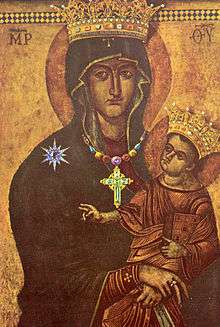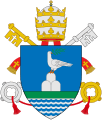Fulgens corona
Fulgens corona ("Radiant Crown") is an encyclical by Pope Pius XII, given at St. Peter's, Rome, on 8 September 1953, on the Birthday of the Virgin Mary, the fifteenth year of his Pontificate. The encyclical proclaims a Marian year for 1954, to commemorate the centenary of the definition of the dogma of the Immaculate Conception of the Virgin Mary. Fulgens corona is significant as it contained the mariological methodology of Pope Pius XII and his views on limits and challenges of mariology.

First Marian year
In September 1953, Pope Pius XII inaugurated the Roman Catholic Church's First Marian Year, or "Little Holy Year," devoted to the Virgin Mary who had always been the object of his special veneration. He announced the Marian Year in his encyclical letter Fulgens corona.[1] Hundreds of thousands of Romans lined the route of the papal cortege when Pius XII, in one of his rare appearances in the streets of Rome, went to the Basilica of St. Mary Major to open the Marian Year on 8 December 1953, the 99th anniversary of the proclaiming of the dogma of the Immaculate Conception of Mary by Pope Pius IX.
Pius XII begins by recalling his predecessor, Pope Pius IX, who with "apostolic authority defined, pronounced and solemnly sanctioned "that the doctrine, which holds that the Most Blessed Virgin Mary at the first moment of her conception was, by singular grace and privilege of the Omnipotent God, in virtue of the merits of Jesus Christ, Savior of the Human race, preserved from all stains of original sin, is revealed by God, and therefore to be firmly and resolutely believed by all the faithful." (Dogmatic bull Ineffabilis Deus, of Dec. 8, 1854.)"[2]
Basic teachings
The Pope stated that the Blessed Virgin Mary, herself seemingly wished to confirm the definition, since less than four years after, in the French town of Lourdes, appeared at the grotto of Massabielle.[3] Pius XII traced the doctrine of the immaculate conception through Sacred Scripture and the early fathers. "...[I]t is clearly apparent that there is only one among all holy men and women about whom it can be said that the question of sin does not even arise, and also that she obtained this singular privilege, never granted to anyone else, because she was raised to the dignity of Mother of God."[4] "...[A]ny honor and veneration which we may give to our Heavenly Mother undoubtedly redounds to the glory of her Divine Son, not only because all graces and all gifts, even the highest, flow from Him as from their primary source, but also because 'The glory of children are their fathers'" (Book of Proverbs, XVII 6)."[5]
Pope Pius XII links the solemn definition of the Immaculate Conception with the dogma of the corporal Assumption of the Virgin Mary into Heaven, promulgated in Pius's apostolic constitution Munificentissimus Deus[6] of November 1, 1950. To Pius, the two doctrines are complementary. "And so these two very singular privileges, bestowed upon the Virgin Mother of God, stand out in most splendid light as the beginning and as the end of her earthly journey; for the greatest possible glorification of her virgin body is the complement, at once appropriate and marvelous, of the absolute innocence of her soul, which was free from all stain; and just as she took part in the struggle of her only-begotten Son with the wicked serpent of Hell, so also she shared in His glorious triumph over sin and its sad consequences."[7]
Pope Pius XII invited all Catholics to celebrate the Marian Year to be held the whole world over from the month of December 1953 until the same month of the coming year, and urged them to be mindfull "that she repeats to each of us those words, with which she addressed the servers at the wedding feast of Cana, pointing as it were to Jesus Christ: "Whatsoever He shall say to you, do ye" (John. 2. 5)[8]
He further noted that in many places, Catholic clergy are "banished, or thrown into prison without just cause, or else are so harassed that they are unable to carry out their duties properly... in those same places they are not allowed to have their own schools and training colleges, that they cannot publicly teach, defend or propagate Christian doctrine in periodicals or commentaries, and cannot properly train the youth in accordance with the same doctrine."[9] He asks for worldwide special prayers, that the sacred rights which are proper to the Church, and which the very exercise of human and civil liberty demands, may be openly and sincerely recognized by all.[10]
Quote
- We desire in the first place to direct Our exhortation, inspired by ardent charity, to those who, reduced to silence and trapped by all sorts of cunning snares, look with anguish of soul at the affliction and distress of their Christian community, left destitute of all human help. Let these, our dearly beloved brothers, also join with us and all other Christians in invoking before the Father of mercies and the God of all consolation (Cf. 2 Cor. 1. 3) the most powerful patronage of the Virgin Mother of God, our mother also, and let them ask her for heavenly aid and Divine consolation. Persevering in the ancient Faith with undaunted courage, let them take as their motto of Christian fortitude in this time of trial the words of the Mellifluous Doctor: "We shall stand and fight to death, if needs be, for (the Church) Our Mother, and with lawful weapons: not with the sword and shield, but with prayers and sighs to God [11][12]
See also
- Ad Caeli Reginam
- Marian papal encyclicals and Apostolic Letters
References
- "Fulgens Corona", The Tablet, October 3, 1953
- Pope Pius XII, Fulgens corona, September 8, 1953, §1, Libreria Editrice Vaticana
- “Fulgens Corona". The Furrow, vol. 4, no. 11, 1953, pp. 662–664. JSTOR
- Fulgens corona §10.
- Fulgens corona §15.
- AAS, 42: 754
- Fulgens corona §21.
- Fulgens corona §24.
- Fulgens corona §41.
- Fulgens corona, §42
- (St. Bernard, Epistle 221. 3: Migne PL 182. 36, 387).
- Fulgens corona, 42
Pope Pius XII, Mariological encyclicals and bulls
- Acta Apostolicae Sedis. (AAS), Vatican City 1939-1958. Official documents of the Pontificate of Pope Pius XII, Fulgens corona 1953, 577
